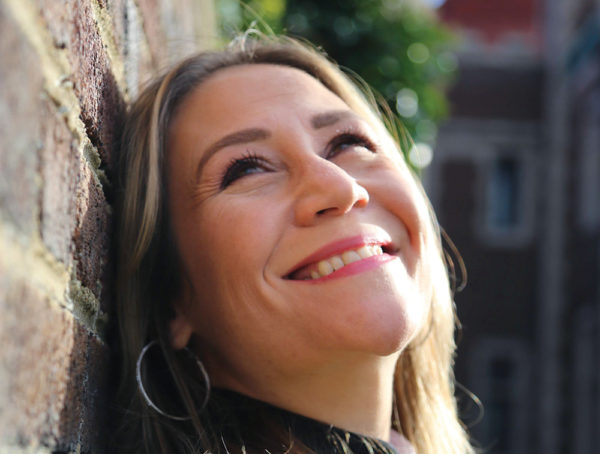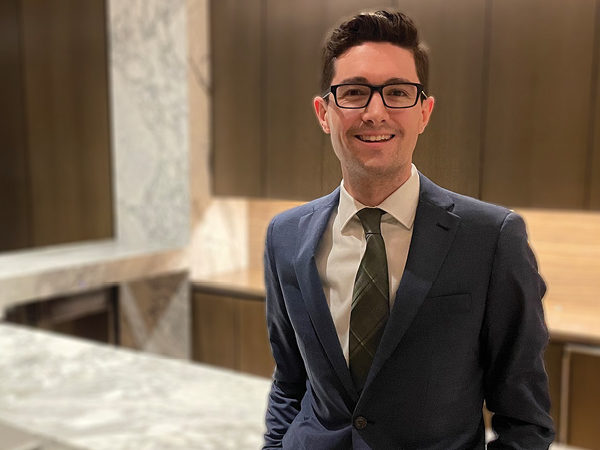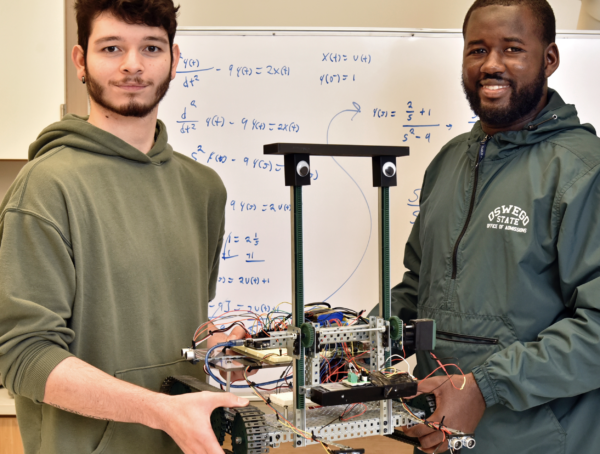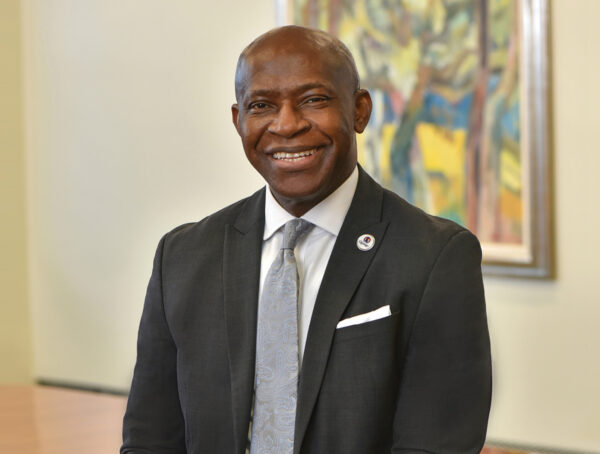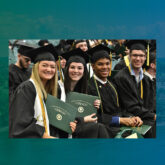Educator shows students the path to prosperity and equality
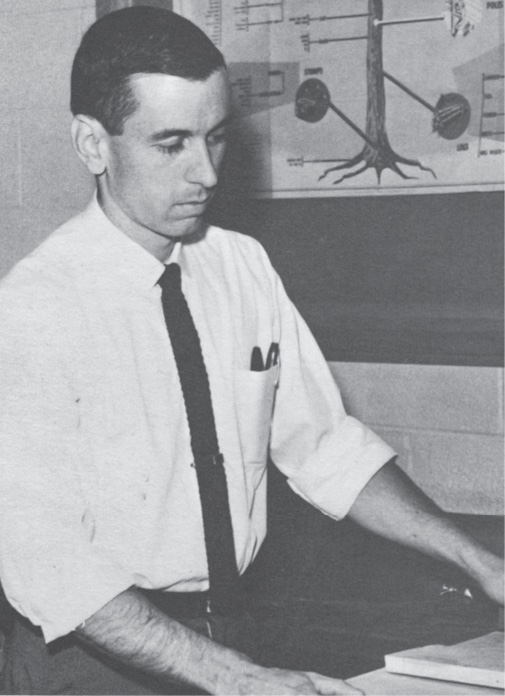
Wayne Chesbrough ’74, pictured here in a industrial arts classroom in the 1968 Ontarian, was tapped to teach at SUNY Oswego while still a student.
Sometimes it’s consistency—or the lack of variability—that leads to the biggest changes.
Retired teacher and administrator Wayne Chesbrough ’74 said education is a great equalizer that can set troubled youths on the right path, provide students from families of limited means the tools to succeed and hold more entitled students to the same standards.
As an industrial arts teacher, vice principal, principal and superintendent in the Lisbon (N.Y.) Central School District for more than three decades, Chesbrough helped transform the lives of thousands of students.
Shortly after writing the district’s first-ever Code of Student Conduct handbook and initiating its adoption, Chesbrough, in his early days as a new administrator, had his beliefs tested; the son of the then superintendent set off a smoke bomb in the school’s cafeteria.
“I suspended him for five days,” Chesbrough said. “After this was all over, the superintendent came down and said, ’Wayne, that took a lot of guts to suspend my son when you just took this job.’ I said, ’Well, we got this handbook now, and I’m going to follow it.’ He said, ’Stick to your guns, and you’re going to be successful.’”
Chesbrough also recalled a conversation in his driveway with a then recent graduate of Lisbon High whom he had had to suspend four times.
“This young man walked up to me and said, ’You disciplined me like the rest of the kids and didn’t make choices based on my last name. You encouraged me to stay in school and graduate,’” Chesbrough said. “He also went to college and has been very successful in his career. I hated seeing teachers label kids. Everyone deserves a fair shot.”
Chesbrough also served as the president of the teachers’ union, negotiating contracts and advocating for teachers’ rights. When he became the district’s superintendent, he said the teachers knew he’d be fair with them.
“I knew the teachers well, and we worked very well together,” Chesbrough said. “I never had a budget defeated, and we always had a contract on time.”
Setting Up Shop
Chesbrough’s influence on the small, rural district and its graduates stretches around the globe.
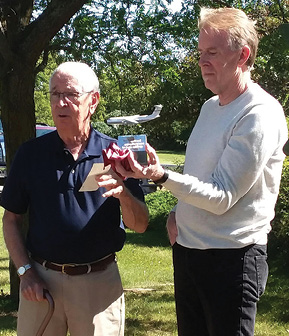
Chesbrough receives a sculpture of a plane from former student, Charles LaFaver.
Recently, three former students from the 1970s reminded him of the impact he has had. They sent him a 10-page typed letter filled with memories of their time at Lisbon High School and their interactions with Chesbrough. They made a small sculpture of a Lockheed Martin C5-A Aircraft and presented it to him in Lisbon in 2021.
“I’ve flown this aircraft around the world many times, over several wars, in and out of trouble zones,” said Charles LaFaver, who graduated from Lisbon High School in 1979. “It has carried cargo that changed the world to be a better, safer place. You are part of that!”
LaFaver and classmates, Jerrald C. Hyde and Timothy L. Ladouceur, shared stories of their antics in high school and how Chesbrough engaged them in the industrial arts shop and encouraged them to stay the course and graduate, even when their own wills were wavering.
“I regret that I’ve waited 40 years to tell you,” LaFaver said. “I’ve carried our experiences through life and they have always been in my heart since those days. Many of the things I mentioned [in the letter to Chesbrough] are always on the forefront of my present-day commitments and decisions.”
Assembling the Parts
Chesbrough understood how education can be interrupted and also how finishing the course can open up opportunities in life.
He first came to SUNY Oswego in 1961, a graduate fresh out of the small, rural high school in St. Regis Falls, N.Y.
“It was great,” Chesbrough said. “I really enjoyed Oswego.”
But during the summer after his sophomore year, he was involved in a very bad car accident. Because of the injuries sustained, he couldn’t work and had no money to return to Oswego that fall.
“I started looking for a job because I wanted to finish college,” he said. He found a job in a cotton mill, but not satisfied with that work, he decided to enlist in the U.S. Air Force. He was medically discharged from basic training, due to severe asthma.
“I tried to appeal it, but was denied,” he said. He then accepted a position at Eastman Kodak in Rochester, N.Y., and met and married his wife, Glenda. His life seemed to be moving him away from completing his degree at SUNY Oswego.
About 3 ½ years into his Kodak job, he received a phone call from his high school industrial arts teacher. Lisbon Central School had been looking for an industrial arts teacher for six months and had no applicants.
Although Chesbrough only had two years of college, the district was desperate and made an exception to hire him in a probationary two-year appointment. His wife found a job as an administrative assistant in the district, too.
“I really liked it,” he said. When the probation period was up, the district didn’t want him to leave, but they needed him to get his college degree and teaching certification.
He returned to Oswego part time, then full time, finishing his degree in 1974 and attending graduation with his wife and two young daughters.

Replicating the Model

Chesbrough is pictured here with daughters, Julie Chesbrough Mitchell ’92 (left) and Kathy Chesbrough Foster ’94 in 2022.
Little did he know then, that he would become his daughters’ role model and that they would follow in his footsteps.
“I always knew I wanted to be a teacher,” said Julie Chesbrough Mitchell ’92, his eldest daughter, an English teacher at Fairport (N.Y.) High School. “I always was very focused on what our dad was doing. I used to play school in his classroom on the chalkboard. I felt very comfortable when I visited SUNY Oswego, so I decided to do that.”
When it came time for Chesbrough’s youngest to apply to college, she looked to her family.
“I went to SUNY Oswego because my dad and my sister did, and I had visited Julie there,” admitted Kathy Chesbrough Foster ’94, who majored in English education. “I also went the educational route because that’s what was in my family, and I ended up really liking it.”
Foster said she loved the social aspects of Oswego, too, and was involved in intramural sports and Phi Sigma Sigma sorority, following the lead of her dad—who is a Beta Tau Epsilon brother.
Foster went on to earn a speech pathology degree at SUNY Fredonia, and worked as a speech pathologist in the Rochester (N.Y.) City School District before becoming an assistant coordinator for clinical therapies at Monroe #1 BOCES.
Chesbrough said he never encouraged his daughters to become educators nor to attend Oswego, but he is very proud that they did both. His daughters said it was impossible not to be inspired by their father and his passion for his profession.
“I always was in awe of the way that he encouraged and nurtured relationships with students,” Mitchell said. “I just thought, ’Gosh, I wish I could make a difference like that.’”
Foster thought she might also like the field of education because so much of the work involved building relationships with other people.
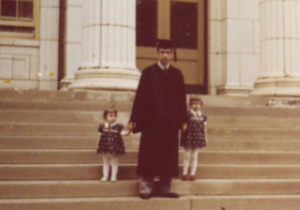
Chesbrough is pictured here with daughters, Kathy Chesbrough Foster ’94 (left) and Julie Chesbrough Mitchell ’92 on the steps of Sheldon Hall in 1974.
“Every day there’d be some exciting story he would have to tell, and I think that’s really what made me gravitate to education,” Foster said. “You can have your plans for the day, but the kids are going to drive that plan. That’s what made students love our dad.”
Chesbrough said what makes a successful educator is enjoying students—and all the unpredictability that they bring to school every day.
“If you’re a teacher and you come home at night and say, ’Oh, that’s such a boring job,’ then you’re not doing something right,” Chesbrough said. “You’ve missed the mainstay of your whole vocation. I don’t think it’s ever boring when you’re dealing with kids.”
His daughters often consult with Chesbrough when a problem arises in their classroom or with another teacher or administrator, and he enjoys being able to share his experience and provide a little guidance.
“My sister and I are in the field of public education because of what we witnessed with our father’s fairness and quest for equity,” Mitchell said. “He understood the difference a good education and personal recommendations could actually make for young people. We are incredibly proud of our Dad, and believe this is the ’stuff’ teachers are made of.”
You might also like
More from Featured Content
Vision for the Future
VISION for the Future Peter O. Nwosu began his tenure as the 11th president of SUNY Oswego, building on the solid …
Envisioning the Potential in All Students
ENVISIONING the Potential in All Students Educator donates $2 million in recognition of his Oswego education, in support of future teachers Frank …
A Vision of Support
A VISION of Support Award-winning principal makes an impact on her school through her positivity and commitment When Nicole Knapp Ey ’02 …







